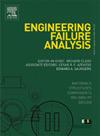Research on the fracture toughness of pipeline steel X80 in a hydrogen environment
IF 4.4
2区 工程技术
Q1 ENGINEERING, MECHANICAL
引用次数: 0
Abstract
Hydrogen pipelines offer an efficient transportation method, but they pose significant safety challenges due to hydrogen embrittlement. The effect of hydrogen pressure on the fracture toughness of pipelines requires further investigation. This study examines the fracture toughness of pipeline steel exposed to high-purity hydrogen gas at various pressures. The experimental results indicate that the fracture toughness decreases progressively with increasing hydrogen pressure, following a trend resembling logarithmic or power-law behavior. Microscopic analysis reveals a shift in the fracture mode from ductile dimple-dominated failure to brittle fracture as the pressure increases from 0 to 12 MPa. Two empirical relationships are evaluated: the theoretically derived Kim model and its X80 calibrated version. The calibration of the Kim model has reduced the relative error of the model for X80 fracture toughness under varying hydrogen pressure conditions. Additionally, an empirical relationship that provides a lower bound of fracture toughness based on the measurements in this study has been developed. And the model is shown to also bound the data in the literature for X80 in gaseous hydrogen at pressure up to 12 MPa at room temperature. These findings provide valuable insights into assessing the structural integrity of hydrogen pipelines.
管道钢X80在氢环境中的断裂韧性研究
氢气管道提供了一种高效的运输方式,但由于氢气脆,它们带来了重大的安全挑战。氢气压力对管道断裂韧性的影响有待进一步研究。本研究考察了管道钢在不同压力下暴露于高纯氢气中的断裂韧性。实验结果表明,随着氢气压力的增加,断裂韧性呈对数或幂律趋势逐渐降低。微观分析表明,随着压力从0到12 MPa的增加,断裂模式从韧性韧窝为主转变为脆性断裂。评估了两种经验关系:理论推导的Kim模型及其X80校准版本。通过对Kim模型的校正,减小了模型在不同氢压力条件下对X80断裂韧性的相对误差。此外,还建立了一个经验关系,该关系提供了基于本研究中测量的断裂韧性的下限。结果表明,该模型与文献中X80在室温下压力高达12mpa的气态氢中的数据相结合。这些发现为评估氢气管道的结构完整性提供了有价值的见解。
本文章由计算机程序翻译,如有差异,请以英文原文为准。
求助全文
约1分钟内获得全文
求助全文
来源期刊

Engineering Failure Analysis
工程技术-材料科学:表征与测试
CiteScore
7.70
自引率
20.00%
发文量
956
审稿时长
47 days
期刊介绍:
Engineering Failure Analysis publishes research papers describing the analysis of engineering failures and related studies.
Papers relating to the structure, properties and behaviour of engineering materials are encouraged, particularly those which also involve the detailed application of materials parameters to problems in engineering structures, components and design. In addition to the area of materials engineering, the interacting fields of mechanical, manufacturing, aeronautical, civil, chemical, corrosion and design engineering are considered relevant. Activity should be directed at analysing engineering failures and carrying out research to help reduce the incidences of failures and to extend the operating horizons of engineering materials.
Emphasis is placed on the mechanical properties of materials and their behaviour when influenced by structure, process and environment. Metallic, polymeric, ceramic and natural materials are all included and the application of these materials to real engineering situations should be emphasised. The use of a case-study based approach is also encouraged.
Engineering Failure Analysis provides essential reference material and critical feedback into the design process thereby contributing to the prevention of engineering failures in the future. All submissions will be subject to peer review from leading experts in the field.
 求助内容:
求助内容: 应助结果提醒方式:
应助结果提醒方式:


